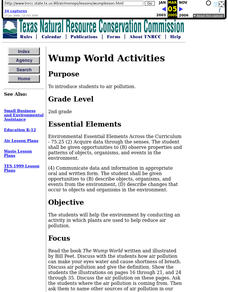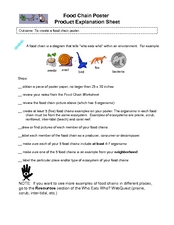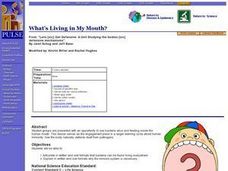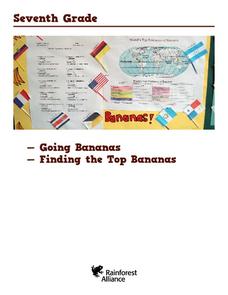Curated OER
Biodiversity
In this biodiversity worksheet, students sort and classify animals by their observable features using a dichotomous key. Students then respond to questions about complete and incomplete metamorphosis.
Curated OER
Skin, Tongue and Nose
In this skin, tongue, and nose worksheet, students answer multiple choice and short answer questions about the skin, tongue, and nose. students complete 19 questions.
Curated OER
Who Can Harvest A Walleye?
Seventh graders investigate the concept of how an ecosystem is put together while conducting research using a variety of resources. They correctly differentiate between a herbivore and carnivore by placing them in the order of hierarchy...
Curated OER
Macroinvertebrate Simon Says
Pupils study the four groups of macroinvertebrates. In groups, they explore the characteristics of macroinvertebrates. Through playing a "Macroinvertebrate Simon Says" game, students discover the adaptations of the animals and their...
Curated OER
The Web Of Life - Overlapping Food Chains
Students perform an activity in which they discover what happens when food chains overlap in an ecosystem and discover the three components of a food web.
Curated OER
The Chain Gang
Students perform a food chain simulation to determine what happens when a food chain is broken.
Curated OER
Wump World
Second graders read ead the book The Wump World written and illustrated by Bill Peet. Discuss with the students how air pollution can make your eyes water and cause shortness of breath. Students discuss air pollution and give the...
Curated OER
WHY WE AREN'T FILTER FEEDERS
Students describe three methods of obtaining food: scavenging, filter feeding, and hunting. They describe three methods of obtaining food: scavenging, filter feeding, hunting, and list at least two reasons why humans are not considered...
Curated OER
Food Type And Calories Per Square Meter
Students compare the efficiency of producing food calories in different types of food then calculate how much land is required to supply their food for a year. They then graph the results.
Curated OER
Water Quality and the St. Mary¿¿¿s River Project Monitoring
Learners list different parameters of water and explain how each is important to the balance of the St. Mary ecosystem. They identify the different instruments and explain what they test.
Curated OER
Food Chain Poster Instructions
In this food chain worksheet, students follow a set of 9 steps to create a food chain poster. Page has no additional activities.
Curated OER
CSI Clamshell Investigation
Students explore predator/prey relationships. They research information on moon snails and claims. Students draw conclusions from the data collected. They use math and graphing to determine if there is a relationship to the clam's size...
Curated OER
Breaking News English: Models Under 16 Banned in London
In this English activity, students read "Models Under 16 Banned in London," and then respond to 1 essay, 47 fill in the blank, 7 short answer, 20 matching, and 8 true or false questions about the selection.
Curated OER
The Environment: Vocabulary
In this environment vocabulary worksheet, students complete 12 multiple choice questions, then translate a set of "environment words."
Curated OER
Urban Safari: A Walk on the Wild Side
Learners discover the urban ecosystem through a series of activities. They explore both the biotic and abiotic factors of the urban environment.
Curated OER
SAV Plants of the St. Mary¿¿¿s River Ecosystem
Students examine the importance of submerged aquatic vegetation in the St. Mary River ecosystem. They identify different characteristics of common eelgrass and discuss water quality, photosynthesis, habitat, oxygen production.
Curated OER
Memory Game Art Project
Students create a memory game featuring the Arctic and, more particularly, the Arctic hare. They examine a few pictures on a website embedded in this plan in order to get an idea of the Arctic landscape and the activities of the Arctic...
Curated OER
What's Living in My Mouth?
Students articulate in written and oral formats that bacteria can be found living everywhere. They explain in written and oral formats why the immune system is necessary. Students are presented with an opportunity to see bacteria alive...
Curated OER
Aquatic Insects: Water Quality Index & Diversity Index
Pupils search stream beds to study the life cycle and adaptations of stream insects. They explore creeks and streams to see the diversity index of creeks or streams and to find the water qualit index.
Curated OER
Build a Bug
Young scholars design an ideally adapted macroinvertebrate to live in a water habitat. They illustrate their animal, name it and specify the adaptations it has that enable it to survive.
Curated OER
Honduras: Going Bananas
Students explore the popularity of bananas. They conduct a survey to understand the reasons for their popularity. Students research a banana's journey from the farm to school lunch. They compose a children's book about bananas explaining...
Curated OER
Animals Spiral Puzzle
In this animal puzzle activity, students use a set of 8 clues about animals to complete a spiral puzzle. A reference web site is included for additional activities.
Curated OER
Household Pests
Sixth graders discover the various habitat requirements for assorted household pests from ants to wasps. They conduct various activities including researching the life cycles moths, cockroaches, and mosquitoes
Curated OER
Insects
Students, through books, videos, and readings, explore characteristics of insects. In groups, they choose an insect to research. Students discover their insect's diet, how they move, and where they live. Afterwards, they use the facts...























